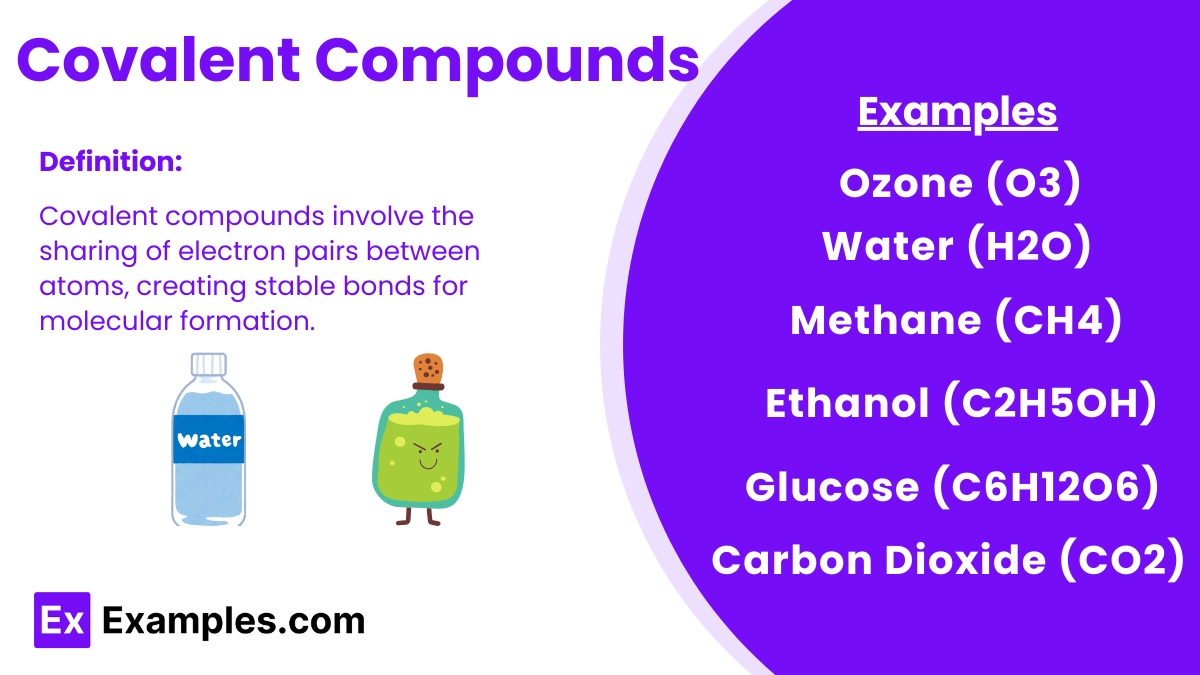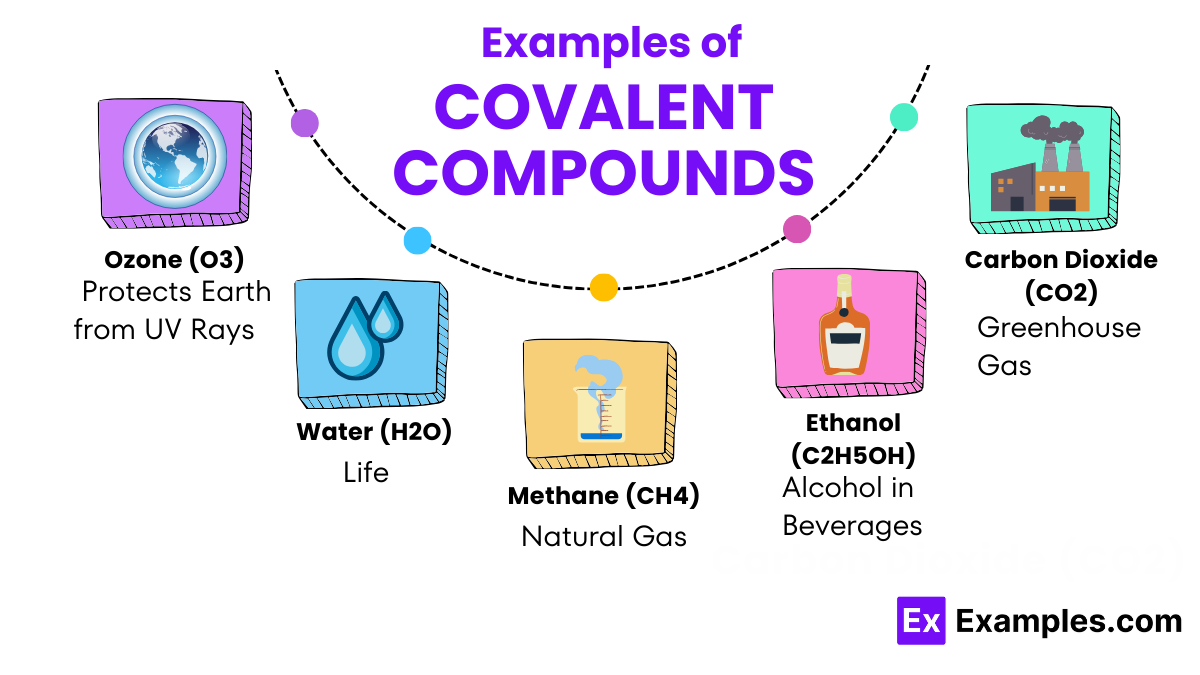What type of bond is formed in covalent compounds?
Ionic bond
Metallic bond
Covalent bond
Hydrogen bond

Covalent compounds are a type of chemical compound where atoms share electrons to stick together. Imagine two friends holding hands to stay connected; similarly, atoms in covalent compounds share their electrons to form a strong bond. This sharing allows them to fill up their outer electron shells, making them more stable and happy, just like how sharing and cooperation make us feel complete and content. These compounds are found all around us, in the water we drink, the air we breathe, and even in the DNA that makes us who we are.
Covalent compounds are characterized by the sharing of electron pairs between nonmetal atoms, forming what is known as covalent bonds. These bonds can range from single, involving one pair of shared electrons, to triple bonds, where three pairs of electrons are shared. This sharing of electrons allows atoms to achieve a more stable electron configuration. The structure of a covalent compound is not just limited to how atoms bond but also includes the arrangement of these atoms in space, which can significantly influence the compound’s physical and chemical properties.
The spatial arrangement of atoms within covalent compounds, or molecular geometry, is determined by the Valence Shell Electron Pair Repulsion (VSEPR) theory, which states that electron pairs around a central atom will position themselves as far apart as possible to minimize repulsion. This leads to well-defined geometrical shapes, such as linear, trigonal planar, and tetrahedral, among others. Additionally, some covalent compounds form extensive networks or macromolecules, such as diamonds or silicon dioxide, where atoms are bonded in a continuous structure, contributing to their high melting points and remarkable strength.
Covalent character in a bond reflects how much it resembles a covalent bond, where atoms share electron pairs instead of transferring electrons. This sharing typically occurs between non-metal atoms with similar electronegativities. Electronegativity, measuring an atom’s electron-attracting ability, helps gauge covalent character: closer electronegativity values indicate more covalent bonds, while larger differences suggest more ionic character. Pauling’s scale estimates this, with differences under 1.7 signaling covalent bonds. Most bonds exhibit a mix of ionic and covalent traits, falling between the extremes.

Naming covalent compounds involves a systematic approach that ensures clear communication about which molecules are being referred to. These steps guide you through the process of naming covalent compounds according to the IUPAC (International Union of Pure and Applied Chemistry) guidelines. Covalent compounds, formed by the sharing of electron pairs between atoms, are primarily composed of non-metal elements.
Start by identifying the two or more non-metal elements that make up the covalent compound. Note the order they appear in the chemical formula, which is usually from left to right on the periodic table.
Use prefixes to indicate the number of atoms of each element present in the compound. The prefixes are as follows:
Write down the name of the first element. If there is only one atom of the first element, you typically do not use the prefix “mono-“. For example, CO is carbon monoxide, not monocarbon monoxide.
For the second element, always use a prefix indicating the number of atoms. Change the ending of the second element to “-ide.” For instance, in CO₂, carbon is followed by “di” for two oxygen atoms, making it carbon dioxide.
Combine the names and prefixes of the elements in the order they appear in the formula. Ensure that the name flows smoothly, occasionally dropping vowels from prefixes (especially “o”) to avoid awkward pronunciation.
Some covalent compounds have common names that differ from their systematic names. It’s essential to be familiar with these as they are often used in literature and discussions. For example, H₂O is more commonly known as water, not dihydrogen monoxide.
| Property | Description |
|---|---|
| State at Room Temperature | Can exist as solids, liquids, or gases, depending on the compound. |
| Melting and Boiling Points | Generally have lower melting and boiling points compared to ionic compounds. |
| Solubility in Water | Solubility varies; some covalent compounds are soluble in water, while others are not. |
| Conductivity | Do not conduct electricity in the solid state but may conduct when melted or dissolved in water if they ionize. |
| Density | Tend to have lower densities compared to ionic compounds. |
| Hardness | Usually softer than ionic compounds, with some being very soft and others hard but brittle. |
Covalent compounds typically have relatively low melting and boiling points compared to ionic compounds. This is because the forces holding the molecules together in a covalent compound (Van der Waals forces or hydrogen bonds) are generally weaker than the ionic bonds in ionic compounds.
In their solid state, covalent compounds do not conduct electricity. This lack of conductivity is due to the absence of free ions or electrons that can move and carry an electric charge.
Many covalent compounds are soluble in organic solvents but not in water. This is attributed to the “like dissolves like” principle, where compounds with similar types of bonds and polarities tend to be soluble in each other.
Covalent bonding is directional, meaning that atoms share electrons in a specific orientation relative to each other. This leads to the formation of molecules with definite shapes.
Covalent compounds can exist in all three physical states (solid, liquid, and gas) at room temperature, depending on the strength of their intermolecular forces.
The reactivity of covalent compounds varies widely, depending on the elements involved and the strength of the bond. Some covalent compounds are highly reactive, while others are very stable.
Covalent compounds form discrete molecules, which are collections of atoms bonded together. This contrasts with ionic compounds, which form large crystal lattice structures.
| Characteristic | Ionic Compounds | Covalent Compounds |
|---|---|---|
| Type of Bond | Formed by the transfer of electrons from one atom to another. | Formed by the sharing of electrons between atoms. |
| Bond Strength | Generally have stronger bonds due to the electrostatic force between ions. | Have weaker bonds compared to ionic compounds because the forces (Van der Waals forces, hydrogen bonds) are not as strong as ionic bonds. |
| Melting and Boiling Points | High melting and boiling points due to strong ionic bonds. | Low melting and boiling points due to weaker forces holding the molecules together. |
| Electrical Conductivity | Conduct electricity in molten or dissolved state due to the presence of free ions. | Do not conduct electricity in solid state because there are no free ions or electrons. |
| Solubility | Soluble in polar solvents like water due to the polar nature of the ionic bonds. | Soluble in non-polar solvents like organic solvents due to the non-polar or slightly polar nature of the covalent bonds. |
| Physical State at Room Temperature | Usually solid due to strong ionic bonds. | Can be gases, liquids, or solids, depending on the strength of the intermolecular forces. |
| Examples | Sodium chloride (NaCl), Potassium bromide (KBr) | Water (H2O), Carbon dioxide (CO2) |
Identifying a covalent compound involves examining its composition, bonding, and properties. Here are key factors:
The strength of ionic vs. covalent bonds varies by context. Ionic bonds are strong due to high lattice energy, contributing to high melting and boiling points. Covalent bonds, though individually might seem weaker, derive strength from electron sharing, the number of shared electrons, and molecular structure, making them crucial in biological and organic compounds. Therefore, “strength” is context-dependent, focusing on different aspects of chemical behavior.
“Covalent bond” comes from “co-” meaning “together” and “valentia” meaning “strength”, referring to atoms sharing electrons to achieve stability. Introduced by G.N. Lewis in 1916, the concept explained molecule formation through electron sharing, allowing atoms to attain a stable electron arrangement. This principle is fundamental in chemistry, underlying the structure and function of various substances, from simple molecules like water to complex macromolecules like DNA and proteins.
Text prompt
Add Tone
10 Examples of Public speaking
20 Examples of Gas lighting
What type of bond is formed in covalent compounds?
Ionic bond
Metallic bond
Covalent bond
Hydrogen bond
Which property is characteristic of covalent compounds?
High melting and boiling points
Conductivity in solid state
Low solubility in water
Low melting and boiling points
What is a common feature of the molecular structure of covalent compounds?
Random arrangement
Fixed lattice structure
Molecules formed by electron sharing
Free electrons
Which element commonly forms covalent bonds with itself?
Sodium
Chlorine
Carbon
Potassium
How do covalent compounds generally conduct electricity?
Well in solid state
Well when molten
Poorly, due to lack of free ions
Only in aqueous solution
Which type of covalent bond involves the unequal sharing of electrons?
Nonpolar covalent bond
Polar covalent bond
Ionic bond
Metallic bond
What is typically necessary for the formation of a covalent bond?
Transfer of electrons
High ionization energy
Sharing of electrons
Presence of metal atoms
In what phase are covalent compounds usually found at room temperature?
Solids
Liquids
Gases
Plasma
What is a result of the definite proportions in covalent compounds?
Variable chemical properties
Consistent chemical properties
Electrical conductivity
High melting points
What impact does electronegativity have on covalent bonding?
No impact
Decreases bond strength
Affects bond polarity
Increases ionization
Before you leave, take our quick quiz to enhance your learning!

